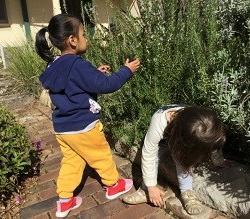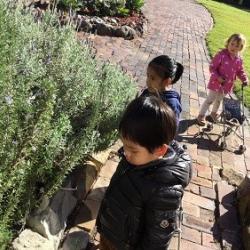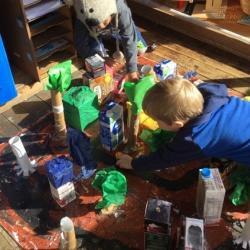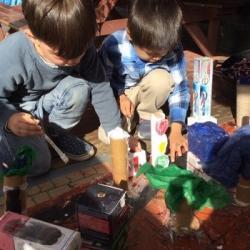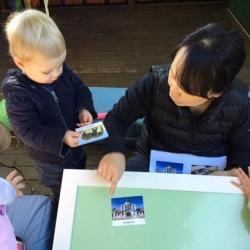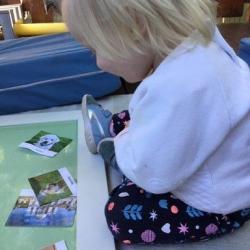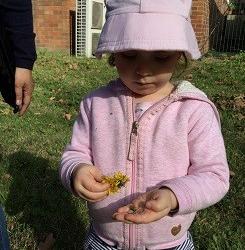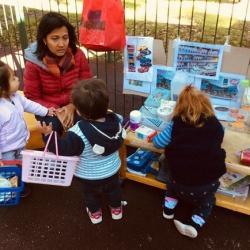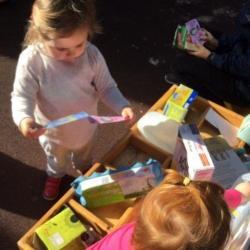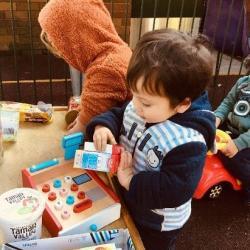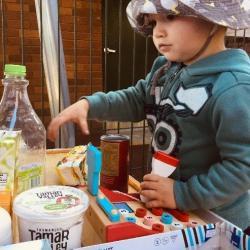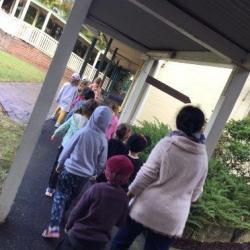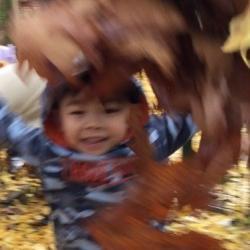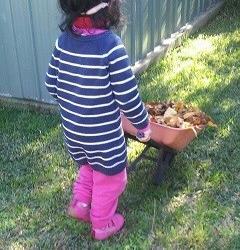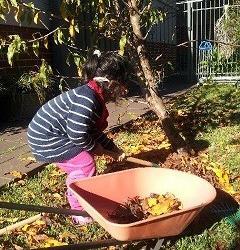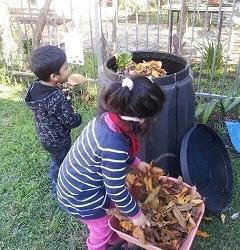Johnson House
Toddlers
The children in Johnson House toddlers have been interested in exploring The Infants’ Home’s gardens. They enjoy looking for insects in the herb garden and exploring the fairy garden, and using their senses to touch, feel and smell. The children were very eager to smell the lavender and rosemary plants, and as they looked at the plants, they also noticed some bees buzzing around. Exploring nature provides children with opportunities to learn about the natural environment and the living things in it.
Preschool
Over the past few weeks the children in Johnson House preschool have been creating a town using a range of recycled materials. Discussions have incorporated children’s knowledge of areas within the local community such as houses, the Bunnings Warehouse behind us, as well as local parks and shopping centres. The children have used boxes and materials to add these buildings and places and they have also added landscapes to create trees and grass. Such projects help to embed the children’s sense of community and they encourage the children to work collaboratively, which is meaningful and can then be used to enrich their play-based learning experiences.
Murray House
Babies
In Murray House babies lots of small group reading experiences have taken place in the past few weeks, and this is becoming part of our daily routine. ‘Dear Zoo‘ and ‘Where is the green sheep?‘ are our children’s current favourites, and they continually request educators to re-tell these stories. In ‘Dear Zoo‘, the children are fascinated lift the flaps to see the animals and to respond with the animal sounds. To support early literacy and foster children’s language development, educators have used a variety of materials like animal figurines and visual flash cards and have added lots of sounds to create enjoyable group reading experiences for the children. Educators are delighted to see the way the children respond to the animal flash cards with actions and naming them.
Toddlers
Our ongoing learning about Australian native flowers has led the children to create flowers using a variety of construction materials. Every afternoon educators provide opportunities for children to explore and revisit this learning experience using construction discs. When talking about the different shapes of the discs, the children associated these with what we perceived as a flower’s basic appearance—a big circle in the middle with smaller circles around this serving as the petals. It’s interesting to observe the process of trial and error as the children recall the shape of a real flower and then try to recreate this using the construction discs. The children gave this their full concentration and they persisted until they had linked every small circle to each slot on the big circle. They also extended their own interest by making smaller flowers, and then converting these flowers into other objects such as wheels. Other learning opportunities were also observed, with children naming all the colours that were present in the small flowers, categorising size—”baby flower” and “Mummy flower”, and transferring their knowledge of how things work by creating a wheel shape that would be able to roll on the table.
Rigby House
The children in Rigby House have been talking about going shopping. As they played they rode their bikes, waved to their educators and said, “Going shopping.” When asked what they bought, many of them told us that they had bought “ice cream and biscuits.”
To extend this interest and their dramatic play skills, the educators set up ‘Rigby Supermarket’. Our families kindly brought in various containers and boxes which we added to our supermarket.
It’s lovely to see the children ‘go shopping’, and to see how much they have learned through shopping with their families. It’s also interesting to see them examine the various items carefully before putting them in their basket or bag. They point to the text on the items, and tell us what they think the item is.
The children enjoy playing with the money and cash registers, and they spend much time discussing the colours and numbers on the play money and cash registers with their educators, before ‘paying’ for their purchases.
It’s lovely to see our young children playing so creatively, and displaying their growing understanding of the importance of numbers and text and how these symbols provide us with much information.
Robinson House
This week the children at Robinson House have enjoyed exploring The Infants’ Home’s grounds in small groups. We have been going on walks each day and observing some of our native trees and plants, and admiring the colours of autumn while touching, smelling and playing with the fallen leaves.
We have sung songs as we threw the leaves up into the air, pretending it’s raining coloured leaves. We have also been collecting a lot of natural resources for our collage and for projects such as building ‘Stick Man’s House’.
We have also been gathering in a circle with educators telling us stories about difference, fairness and belonging. Using natural resources from what we’ve collected, we’ve created characters which have encouraged children to join in with the story telling process.
These experiences inspire and enable children to be in touch with their natural environment and surroundings. The children are learning several dispositions as they explore, experiment and use their imagination together to discover new facts about nature.
Family Day Care
During play sessions at Randwick/South Sydney Family Day Care Sydney Wide the children often participate in gardening experiences. This week they enthusiastically raked the fallen leaves from our peach tree (which was once planted by the children), and then loaded these into wheelbarrows to transport them to the compost bin into which they carefully transferred the leaves. We talked about the importance of adding dry material to the bin as well as morning tea veggie and fruit scraps to make healthy, rich compost. Several loads were accomplished which was actually real gardening work—one less job for the staff! Gardening activities are a great way to assist children to develop respect for the environment and to cultivate dispositions such as curiosity, cooperation, confidence, persistence and commitment.
